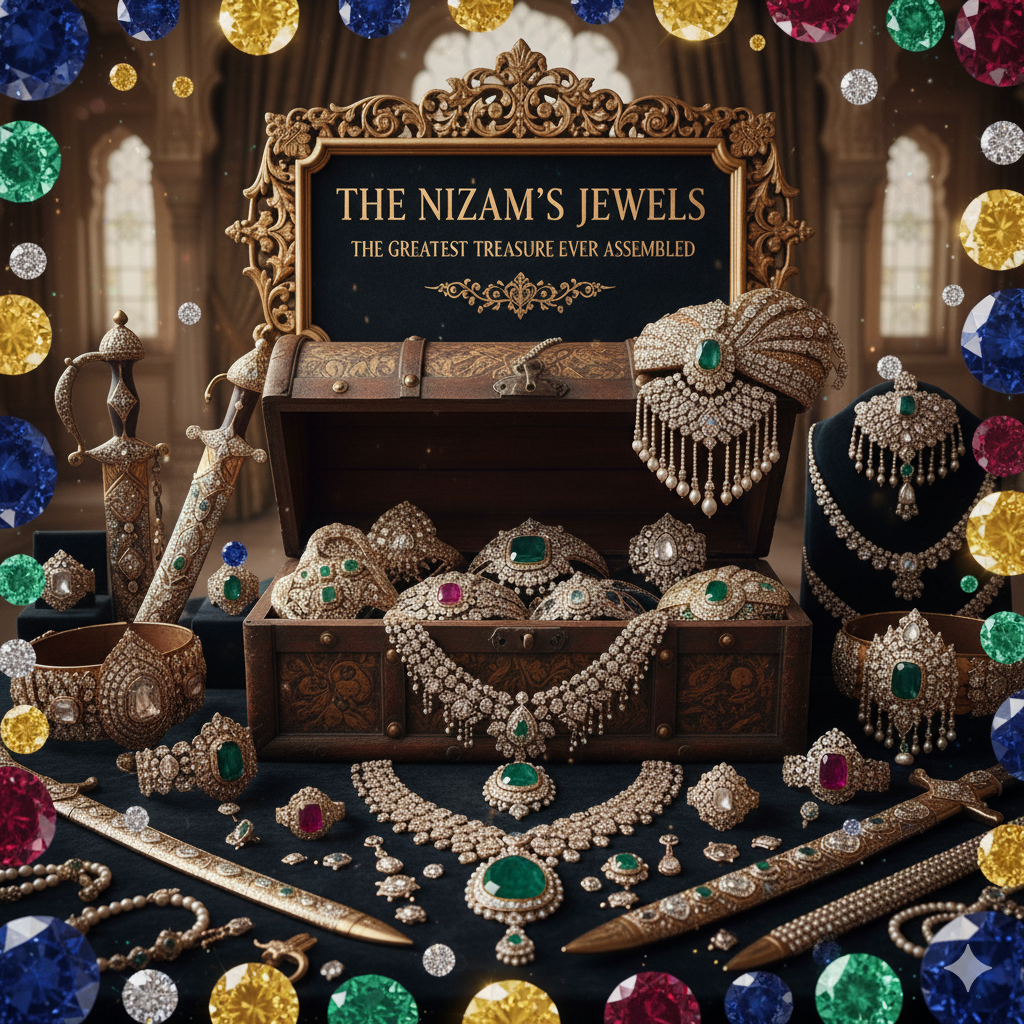Introduction
1) A Kingdom of Light
In the heart of Deccan India once stood a dynasty that measured its power not in armies, but in gemstones.
The Nizams of Hyderabad, descendants of the Asaf Jahi line, presided over one of the richest kingdoms in the modern world — a realm where diamonds were currency and pearls were breath.
At its height, Hyderabad’s treasury was estimated at over ₹11 billion (in 1930s value) — wealth so vast it rivalled empires.
But beyond numbers, it was the artistry that made it legendary: the Nizams were collectors, not hoarders — custodians of light in its purest form.
2) The Origin of a Legend
Hyderabad’s wealth began with the Golconda diamond mines, whose earth birthed the world’s most famous gems — the Koh-i-Noor, the Hope Diamond, the Regent, and hundreds more that graced global crowns.
When the mines waned, the Nizams turned to the Arabian Gulf, where divers risked their lives to retrieve Basra pearls, the whitest and most luminous ever known.
They built trade routes across Bombay, Bahrain, and Basra — their caravans carrying silk, perfume, and oceans of nacre.
By the early 20th century, Hyderabad had become the jewelry capital of the East, its artisans combining Persian intricacy with Indian soul.
3) Mir Osman Ali Khan — The Collector King
The seventh Nizam, Mir Osman Ali Khan Bahadur (1886–1967), was the last great custodian of this treasury.
He was known for his austerity in public life but possessed the largest private jewelry collection ever recorded — a fortune later appraised at billions of dollars.
His court combined European refinement and Mughal tradition — Cartier met Bidri, Tiffany met Turquoise.
And while he appeared modest, his vault contained gems that even monarchs of Europe envied.
4) The Vaults of Hyderabad
After India’s independence, officials catalogued the treasure under tight secrecy.
When the vaults were opened, the inventory stunned the world:
- Over 25,000 individual gems
- 22,000 pearls (mostly Basra)
- 173 precious ornaments
- Emeralds, rubies, spinels, and Golconda diamonds beyond calculation
Among them:
- The Jacob Diamond — a flawless 184.75-carat Golconda stone, the world’s fifth largest, once used by the Nizam as a paperweight.
- Emerald necklaces of 300 carats each.
- Pearl necklaces over six feet long.
- Turban ornaments (sarpech) laced with emerald drops the size of grapes.
Each piece was not mere display but a fragment of Hyderabad’s spiritual and aesthetic philosophy — opulence without arrogance.
5) The Jacob Diamond — A Silent Sun
No tale of the Nizam’s jewels is complete without the Jacob Diamond.
Discovered in the 19th century and named after Alexander Jacob, a Simla jeweller, the stone passed through courts and intrigues before being purchased by the sixth Nizam.
Forgotten for decades, it was rediscovered wrapped in newspaper in a shoe box after the king’s death.
Weighing nearly 185 carats, internally flawless and colorless, it remains one of the purest diamonds ever cut.
Its fire is described as “moonlight condensed.”
Unlike the Koh-i-Noor, it has never been recut, preserving its Golconda integrity — a metaphor for the Deccan spirit itself: unaltered, undimmed.
6) The Ocean’s Breath — Basra Pearls
If diamonds were Hyderabad’s pride, Basra pearls were its soul.
These natural pearls, harvested from the Arabian Gulf, were prized for their unmatched whiteness, orient, and fine skin.
The Nizam’s vaults contained hundreds of strands, many reaching the floor when worn.
Pearl tassels adorned swords, belts, anklets, turbans, and even bridles for royal horses.
Each strand was graded by tone — cream, silver, rose — and matched into harmony like musical notes.
The finest Basras were reserved for court durbars and diplomatic portraits, glowing softly against the Nizam’s snow-white robes.
7) The Emerald Palaces
The Nizam’s love for Colombian emeralds was almost poetic.
He collected them not for flamboyance but for their calm green — symbolic of balance and intellect in Islamic tradition.
Among the most famous were:
- A seven-row emerald necklace weighing over 300 carats.
- Turban ornaments (sarpech) set with teardrop emeralds encased in diamond halos.
- A sword hilt inlaid entirely with emeralds, rubies, and gold filigree.
These were not gaudy trophies; they were manifestations of devotion — the belief that beauty was a form of worship.
8) The Artisans of Deccan
Behind every masterpiece stood Hyderabad’s master craftsmen — goldsmiths, enamelists, and stone-cutters who merged Persian finesse with Indian warmth.
They created wonders like:
- The Kundan-Meenakari sarpech, where enamel painting met diamond geometry.
- Pearl-encrusted turban clips, worn by princes during Eid and coronations.
- Chandbalis, crescent earrings inspired by the city’s own Charminar.
Each ornament carried subtle Islamic motifs — crescents, stars, verses — hidden in the curves of gold, visible only to the devout eye.
9) The Jewelry of Faith and Power
For the Nizams, jewelry was never vanity; it was symbolic grammar.
Diamonds signified divine light (nur), emeralds represented paradise, and pearls embodied purity and humility.
A royal audience shimmered not in display but in discipline — symmetry, repetition, and spiritual geometry.
Their jewels told the world: We command wealth, but we bow to beauty.
10) The Cartier Connection
In the 1920s and 30s, the Nizams began commissioning jewels from Cartier, Van Cleef & Arpels, and Boucheron, sending their best gems to Paris for setting.
The result was a spectacular Indo-European fusion — Deccan gems framed in Art Deco precision.
Cartier’s archives describe these orders as “the largest single commissions ever undertaken.”
Necklaces and tiaras crafted for Hyderabad became benchmarks for global jewelry design — bridging Mughal grandeur and Western modernity.
11) The Women Behind the Glow
The royal zenana of Hyderabad housed women of education and refinement who valued jewels as heritage.
Princess Durru Shehvar, the Turkish princess who married Azam Jah (the Nizam’s heir), introduced Ottoman subtlety into the court’s jewelry aesthetic — preferring pearls and soft-hued diamonds over heavy gemstones.
Her presence redefined royal adornment as something serene and intelligent rather than merely ostentatious.
12) After the Empire
When India gained independence in 1947, Hyderabad’s integration into the Union marked the end of royal sovereignty.
The Nizam’s treasure was locked under government seal for decades, embroiled in valuation and ownership disputes.
In 1995, the Government of India finally acquired the Nizam’s Jewels Collection for ₹218 crore — a fraction of its real value — preserving it as a national heritage collection under the custody of the Reserve Bank of India and the National Museum.
13) The Exhibition — Light Returns
In 2001, the world saw these jewels for the first time at the National Museum, New Delhi, in an exhibition curated under high security.
Visitors were stunned: emeralds like grapes, pearls like planets, diamonds like frozen stars.
It was not display — it was revelation.
Many described it as standing inside a living galaxy — where every piece glowed with its own gravity.
14) The Aesthetic of Eternity
Unlike Western collections that celebrate conquest, the Nizam’s jewels tell a story of coexistence — Hindu craftsmanship, Persian design, Islamic mysticism, and European precision.
They represent a civilization that could balance opulence with restraint, wealth with wisdom.
To this day, jewel historians call it “the greatest treasure ever assembled by an individual dynasty.”
15) PreciousCarats Reflection — The Meaning of Majesty
At PreciousCarats, the Nizam’s legacy is not about ownership; it is about guardianship of light.
True luxury lies not in possession, but in preservation — the ability to let beauty outlive its maker.
The Nizam’s collection reminds us that gems, like dynasties, only endure when treated with reverence.
16) Closing — The Empire That Still Shines
The empire of Hyderabad may have faded into history, but its light never left.
The pearls still glow, the diamonds still whisper, and the Jacob still rests — silent, perfect, eternal.
Every gem in that vault remains a verse in India’s hymn to beauty.
And for anyone who has ever held a pearl or studied a diamond, the Nizam’s jewels are a reminder of one truth:
Greatness is not in what you own. It’s in what you choose to keep luminous.

